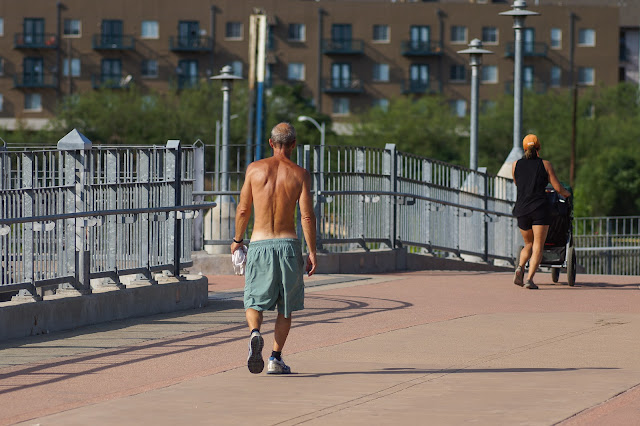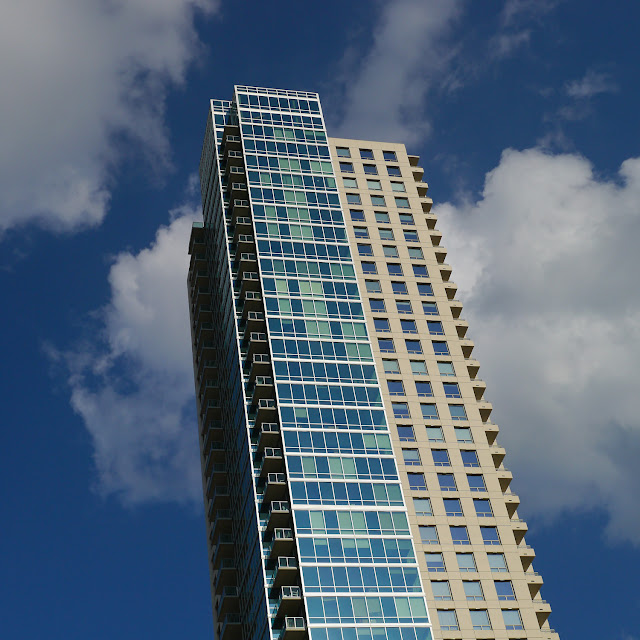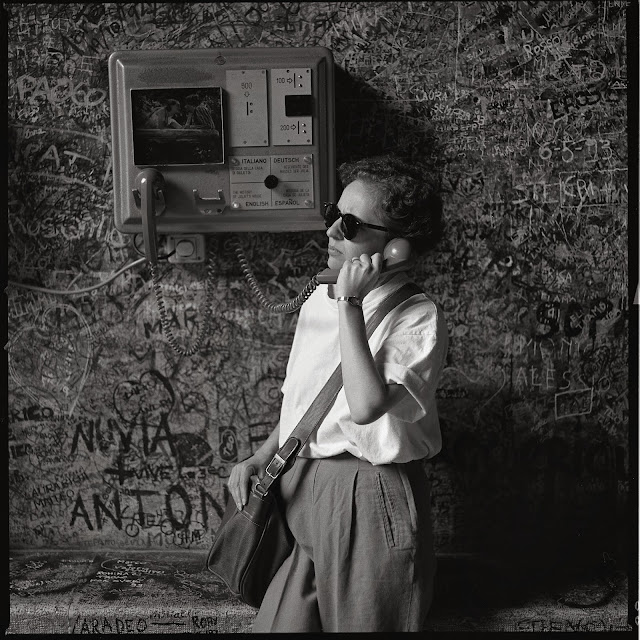(edit: for people who don't know the basic history of digital cameras: The camera above is not a film camera, it is a digital camera from Kodak that was marketed in 2001-2002 and was one of the first "affordable" interchangeable lens digital SLR's to offer a whopping 6 megapixels. About $7,000 on introduction.)
I've just read several blogs wherein the writers pose this very question and then take the middle of the road argument that, "there's room in the camera cosmos for everyone..." Which is a nice way of side-stepping the intellectual honesty of actually taking a stand, but might just be the wrong answer.
Not to enrage the
creationists of photography who feel that all cameras are locked into whatever form they exist in now by some edict, I'd like to make the case that, in order to survive, today's big, hungry and macho DSLRs will evolve by co-opting the best features of their current predators and keeping the goofy and lovable features that marketers
think we all want...
I think that much of what we accept as necessary in a "professional digital single lens reflex camera" is there via precedent, vestigialism and ritual. Most of the voodoo of bigger SLR's is based on what we needed in the early days of digital.
Consider this, in 2002 if you wanted a camera to shoot with professionally at six megapixels (or thereabouts), with the capability of changing lenses (itself partially a conceit from the primitive film days...) and the throughput or frame rate to follow even rudimentary action (buffer), you had very, very few choices. In fact, you had the Nikon D1x and the Kodak DCS760. Both were large body styles. You had to be happy with a large body style because no one had anything else on offer with the same features. Really. So, marketers presumed in their "looking forward calculus" that, since the big bodies were selling well (remember, they were the only form factor widely available with the feature sets needed) consumers must like the big bodies and therefore it was good marketing to offer more big bodies in the future. No matter that the cameras were widely considered to be too heavy and too unwieldy to be comfortable...especially for most woman and men with smaller hands...
It's kind of like being GM in the 1960's and presuming that everyone needed a big, V8 motor because you built lots of big V8 motors and put them in most of your cars and people bought the cars, ergo they must want big V8 motors. And would never change.
I look at the Kodak DCS 760 as one of the seminal, professional, digital cameras because, well, Kodak (using big Nikon bodies and making them even bigger) was there first. And since some of them sold well their competitors, not wanting to take chances, followed suit. I think the first few generations of Kodak digital behemoth cameras were big not because the engineers wanted them to be but because nearly every part, including the electronics, was made by hand and breadboarded circuits take up a lot more space than VLSIs. I also think the engineers were constrained to use a certain body size in order to accomodate the enormous (relative to today's technology) primitive batteries and the large sized industry standard connectors of the day. Not to mention the big, dual slots required for PCMCIA memory constructs.
So, in early
big camera engineering form indeed followed function. Now form follows convention. Form is following history. Form is part of marketing that plays on a nostalgia for the past in the field of cameras, to the detriment of your pocket book.
My Kodak DCS760 batteries weigh more than my entire Panasonic G3. One PCMCIA hard drive is bigger than the biggest LCD screen on my best camera. And yet those cameras didn't shoot faster than my current consumer cameras, didn't have as big buffers, don't have the same resolutions and on and on.
I fully believe that Canon and Nikon could both make a camera with the same capabilities as their D3's, D4's and 1DX's, etc. that are much smaller than the ones they currently make, without making any engineering sacrifices. Same waterproofing, same basic handling and the same performance but they choose to make them big to connote their level of professionalism. Size is now analogous to the fins on a sedan or raw horsepower. Making the cameras bigger and heavier adds to the weight and the cost but not to the usability for most buyers.
In the ten years since the introduction of the big professional digital cameras the top models have remained the same size and weight even as technology has advanced considerably in every metric. The batteries have ten times the capacity of the early ones (measuring in shutter actuations). They weigh less than half of their predecessors. SD cards hold hundreds of times more files and write them thousands of times more quickly than their predecessors. And the engineers have had a decade to leverage the efficiencies of scale for processors, shutter mechanisms, etc. So why do people still think they need to
tote a brick to be taken seriously?
Well, as I said above, I think we're about to see the big dinosaurs evolve instead of just capitulating and becoming instantaneously extinct. If the camera makers are smart they'll make "smaller" a new
luxury feature (as Pentax did with their LX system back in the days of film...). You're already seeing that in coveted cameras like the Fuji X1-Pro.
The next step (look to Sony) will be for Canon and Nikon to "reinvent" the finder. They'll move to EVFs but they'll rename the EVF and make it a professional feature. A "must have" for pros who
need to see all the information. How will they sell it? With fear and uncertainty. You'll hear over and over again that all still photography is nearly dead (and it might nearly be for commercial applications) and that you MUST be shooting video and "we're putting this EVF here to help you be successful!!!!!" And, they'll create (make up) some new feature set that can be construed to be even better than seeing stuff through an "outdated" OVF. You watch them. When they tip the point for sports shooters the marketing will go into overdrive and no one will ever want to go back to the "bad old days" of glass pentaprisms ever again. Not because 99% of buyers need what sports photographers profess to need but because
halo advertising works...
The next thing to go will be the mirror. No need for a mirror if you're looking at the image directly as it appears to the sensor. Right? But again, it will be couched as an advantage because of "high speed performance" metrics. Faster and more reliable. Who doesn't want that? Nikon has already mastered the focusing issues in their lowly V system. They'll roll it up (as they always do) into their pro-sumer and then pro cameras just as quickly as they think you're ready for it....from a marketing point of view.
In a short time we'll have a professional, weather-sealed, mirrorless, EVF'd live view camera with a full frame sensor and a whole raft of new marketing "miracles." How about this information that lens designers have known for decades? :
The shorter the flange to film plane distance the easier it is to design higher performance lenses. And it's true. The moving mirror made/makes for many optical and mechanical compromises. Another linchpin for marketing.
Think it will never, never happen? Look to the moving picture industry where real money changes hands. Real directors and their directors of photography (DP's) have abandoned the moving shutter, moving film cameras of just a decade ago to embrace (now 50% or more of all new movie production) digital video cameras with EVF's and direct-to-sensor technology.
So, the process will look more like evolution. It might start with a lowly Canon Rebel
Eyeview. That camera will use an EVF because it's cheaper to build and looks bigger and better than the current tunnel vision optical finders on entry level cameras. The consumer sees a bigger image. And it's brighter! And the camera is lighter! And it's a little smaller so it fits in a purse or a man bag. And the marketing...
A giant campaign. NOW YOU DON'T NEED SEPARATE CAMERAS FOR VIDEO AND PHOTOS. THIS ONE CAN DO IT ALL!!!!! Make a movie, shot an ad. And the ads will extol being able to see what you get, before you even get it. Once the great mass of the market speaks with their Visa cards the prosumer market will follow. And when people embrace the new products the pro stuff will come out at the next big sports event (Formula One? World Cup? The Superbowl?) with tremendous and heartfelt testimonials from a whole new generation of content creators, who will gush about being able to follow action at 15fps with no vibration, while seeing a perfect image and never loosing an opportunity because of the ability to pre-chimp!
Blogging photographers are just as susceptible to nostalgia and tradition as everyone else. We grew up with a certain form factor and we're well acculturated to believe it's the holy grail of camera designs. But we actually exist in a giant swirling cosmos of alternate designs that are presaged on the
evolution of technology as well as
consumer taste. When the vast majority of buyers used
point and shoot cameras as their daily recorders of events and milestones the DSLR was seen as the "step up" to professional quality.
Working photographers knew that the medium format cameras were the magic beans. Now the vast, vast majority of people who snap photographs do so with cellphones. Even for rudimentary business use. Their perception of stepping up, big time, in quality is to step up to a 16 megapixel camera with interchangeable lenses. (the interchange of lenses being the driving metric...). And now the momentum goes to the mirrorless sector.
And, ultimately, we have to look at our societal shift for every image's final destination. The
prevailing use is also fundamental in determining the form. (Form still follows function). If the end destination is a screen, even a high res screen, then ultimate image quality is no longer the marketing driver. If photography is becoming relentlessly homogenized then sophistication of the instruments takes a back seat to convenience and functionality. That means using equipment that's easier to handle and easier to shoot with. It also means that fast access to the web trumps
ultimates in image size and resolution.s
As the number of full time professional photographers relentlessly shrinks more and more photography will be that of opportunity. And I think you'll agree that opportunity favors those who have
A camera with them over those who own incredible stuff that requires multiple sherpas for transport.
Finally, there really is a melding of video and still photography in the image making of generations under us. My readers and I represent generations that straddled the shift between film and digital. Most of us (not all, I get that) had opened up the back of a film camera and dropped in a roll of something and made sure the film was progressing through our cameras as we shot. But we also were there for the birth of widespread digital and if we are honest with ourselves we can see the thread of yet another change that is all about the rejection of a useful but used up paradigm of "Big, Expensive, Complex" that is being replaced by a new paradigm of "Small, Agile, Useful, Egalitarian." Especially if the quality is maintained at a constant.
If you really think that we'll never
de-embrace from big, OVF, professional DSLRs try a bit of introspection and after some painful probing you might find that it's the mastery of past camera and photography traditions and the growing irrelevance of those mastered traditions that causes us to emotionally reject the inevitable evolution.
Finally, I don't want to get side tracked by sensor arguments. I've written a lot here but I am NOT making the argument that we all will be using smaller sensor cameras. Not at all. Sensor size is a whole other issue and one that still speaks to aesthetic elements of the differentials. I won't deny that a larger sensor camera has different "drawing" characteristics (based on object distance and depth of field, combined). I'm presuming that Nikon and Canon and Sony and Pentax will also come out with evolutionary, EVF, mirrorless cameras that use all three of the major, consumer sensor sizes just as I am certain that medium format digital will continue to sell to service the tiny subset of user for whom perfection and ultimate control trump issues of size, cost and usability.
No one is trying to pry your hands off a full frame (e35mm) sensor. We're just gently suggesting that
form factor changes, driven by technology, are inevitable. Just as cellphones shrank from big ugly boxes in cars to slender, pocketable products while expanding their power at the same time.
It's fun to be in the middle of a swirling set of changes. Never fun when your own "ox" gets gored but change is amoral and nothing if not anti-nostalgic. We'll get over it if we have the intellectual strength to change with our culture.














































